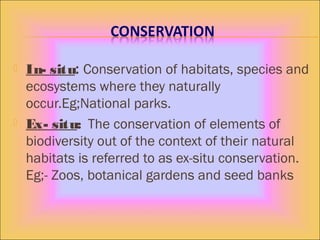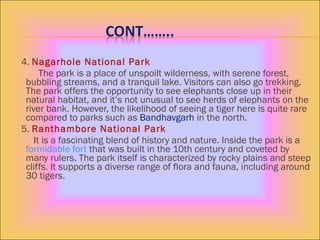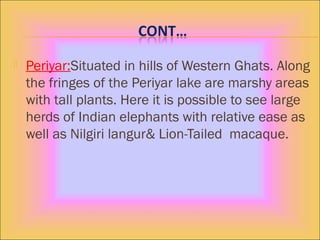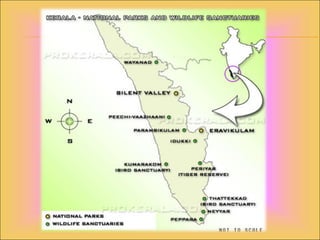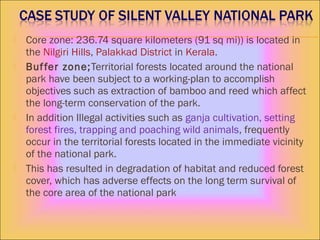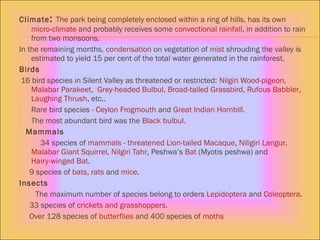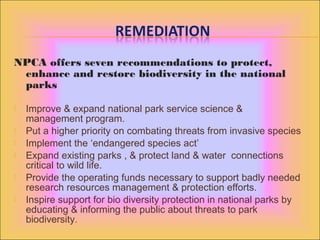National parks.......
- 2. In- situ: Conservation of habitats, species and ecosystems where they naturally occur.Eg;National parks. Ex- situ: The conservation of elements of biodiversity out of the context of their natural habitats is referred to as ex-situ conservation. Eg;- Zoos, botanical gardens and seed banks
- 3. Reserve of natural or semi-natural land, declared or owned by a Government, set aside for human recreation and enjoyment, animal and environmental protection and restricted from most development.
- 4. The largest national park in the world meeting the IUCN definition is the Northeast Greenland National Park. Yellowstone National Park,U.S.A. was the first national park in the world. India’s first national park (an IUCN category II Protected area) is Hailey National Park, now known as Jim Corbett National Park.
- 6. A national park was deemed to be a place with one or several ecosystems not materially altered by human exploitation and occupation, where plant and animal species, geomorphological sites and habitats are of special scientific, educative and recreative interest are conserved. minimum size-1000 hectare. Statutory legal protection. Sufficient budget & staff are need for effective protection. Prohibition of exploitation of natural resources. Visitors are allowed to enter, under special conditions: for inspirational, educative, cultural & recreative purposes.
- 7. 1. Sunderbans National Park It is a magnificent tangle of mangrove jungle that’s the only one of its kind in the world. It’s spread over 54 islands. The Sundarbans is only accessible by boat. Don’t be hopeful of seeing any tigers though. They usually remain well hidden in the reserve. 2. Bandhavgarh National Park It is best known for the highest concentration of tigers in any park in India. The park features dense green valleys and rocky hill terrain, with an ancient fort built on 800 meter (2,624 ft) high cliffs., this park offers the best chance of seeing tigers. 3. Kanha National Park It has the honor of providing the setting for Rudyard Kipling’s classic novel, The Jungle Book. It’s rich in lush saal and bamboo forests, lakes, streams and open grasslands. This large park is well regarded for its research and conservation programs, and many endangered species have been saved there. As well as tigers, the park abounds with barasingha (swamp deer) and an extensive variety of other animals and birds.
- 8. 4. Nagarhole National Park The park is a place of unspoilt wilderness, with serene forest, bubbling streams, and a tranquil lake. Visitors can also go trekking. The park offers the opportunity to see elephants close up in their natural habitat, and it’s not unusual to see herds of elephants on the river bank. However, the likelihood of seeing a tiger here is quite rare compared to parks such as Bandhavgarh in the north. 5. Ranthambore National Park It is a fascinating blend of history and nature. Inside the park is a formidable fort that was built in the 10th century and coveted by many rulers. The park itself is characterized by rocky plains and steep cliffs. It supports a diverse range of flora and fauna, including around 30 tigers.
- 9. SUNDERBANS NAGARHOLE RANTHAMBORE KANHA BANDHAVGARH
- 10. Silent Valley:Commonly known as Sairndhrivanam in India.Park is a unique example of tropical rain forest.The valley has a wide variety of peninsular mammals like tailed macaque lion,Nilgiri Tahr,tiger,leopard etc.. Eavikulam :Set up for the preservation of Nilgiri Tahr.Now the park has the largest known population of Tahrs existing in the world.Also shelters Atlas moths,elephants,tigers etc..
- 11. Periyar:Situated in hills of Western Ghats. Along the fringes of the Periyar lake are marshy areas with tall plants. Here it is possible to see large herds of Indian elephants with relative ease as well as Nilgiri langur& Lion-Tailed macaque.
- 14. Core zone: 236.74 square kilometers (91 sq mi)) is located in the Nilgiri Hills, Palakkad District in Kerala. Buffer zone;Territorial forests located around the national park have been subject to a working-plan to accomplish objectives such as extraction of bamboo and reed which affect the long-term conservation of the park. In addition Illegal activities such as ganja cultivation, setting forest fires, trapping and poaching wild animals, frequently occur in the territorial forests located in the immediate vicinity of the national park. This has resulted in degradation of habitat and reduced forest cover, which has adverse effects on the long term survival of the core area of the national park
- 15. Climate: The park being completely enclosed within a ring of hills, has its own micro-climate and probably receives some convectional rainfall, in addition to rain from two monsoons. In the remaining months, condensation on vegetation of mist shrouding the valley is estimated to yield 15 per cent of the total water generated in the rainforest. Birds 16 bird species in Silent Valley as threatened or restricted: Nilgiri Wood-pigeon, Malabar Parakeet, Grey-headed Bulbul, Broad-tailed Grassbird, Rufous Babbler, Laughing Thrush, etc.. Rare bird species - Ceylon Frogmouth and Great Indian Hornbill. The most abundant bird was the Black bulbul. Mammals 34 species of mammals - threatened Lion-tailed Macaque, Niligiri Langur, Malabar Giant Squirrel, Nilgiri Tahr, Peshwa’s Bat (Myotis peshwa) and Hairy-winged Bat. 9 species of bats, rats and mice. Insects The maximum number of species belong to orders Lepidoptera and Coleoptera. 33 species of crickets and grasshoppers. Over 128 species of butterflies and 400 species of moths
- 16. Flowering plants:701 Dicotyledons distributed among 113 families and 420 genera. There are 265Monocotyledons here distributed among 21 families and 139 genera. Families best represented are the Orchids with 108 species including the rare, endemic and highly endangered orchids Ipsea malabarica, Bulbophyllum silentvalliensis and Eria tiagii, Grasses (56), Legumes (55), Rubiaceae(49) and Asters (45). There are many rare, endemic and economically valuable species, such as cardamom Ellettaria cardamomum, black pepper Piper nigrum, yams Dioscorea spp etc. Trees Six distinct tree associations have been described in the valley. Occurrence of lion-tailed macaque is dependent on the flowering of Cullenia exarillata in the forest
- 17. Major threats include: Habitat loss or degradation Over exploitation Fragmented habitats too small to support a variety of species Invasive species. Lack of funds for scientific research and resource protection. Pressure to drill for oil or build along park boundaries. Over tourism. Threats from forest fire. Natural calamites. Global warming Hunting / poaching.
- 18. NPCA offers seven recommendations to protect, enhance and restore biodiversity in the national parks Improve & expand national park service science & management program. Put a higher priority on combating threats from invasive species Implement the ‘endangered species act’ Expand existing parks , & protect land & water connections critical to wild life. Provide the operating funds necessary to support badly needed research resources management & protection efforts. Inspire support for bio diversity protection in national parks by educating & informing the public about threats to park biodiversity.
- 19. LET’S HOLD OUR HANDS TOGETHER FOR THE PROTECTION OF NATIONAL PARKS MOREOVER FOR BIODIVERSITY…….

